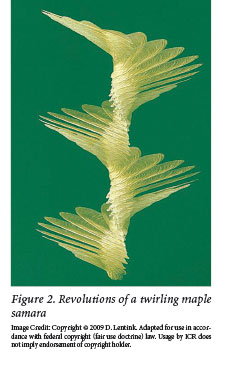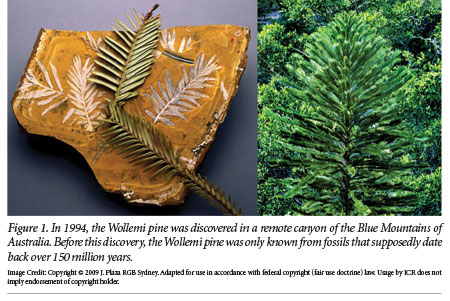
..................................................................................................................................................................
Trees producing fruit,
and the wood of which they are composed, are a testament to God’s creation:
“Out of the ground the Lord God made every tree grow that is pleasant to the
sight and good for food”
BY
FRANK SHERWIN, M.A.
There are few things more beautiful and
soothing than walking through a forest or grove of trees.
Scripture has much to
say about these majestic woody perennials, from the “fruit tree that yields
fruit according to its kind” (Genesis 1:11) to “the tree of life” that
will be freely accessible to all believers (Revelation 22:2).
A number of tree varieties are cited in the
Bible, including cedar, oak, olive, and fig.
Creationists maintain that trees have always
been trees in all of their majestic beauty and design.
.
Evolutionists reject the biblical account of origins and must posit a strictly naturalistic origin of everything, from people to plants.
.
Evolutionists reject the biblical account of origins and must posit a strictly naturalistic origin of everything, from people to plants.
Botanists estimate there are at least 60,000
identified tree species in the world, but what was their origin?
In tracing the
evolution of forest trees, evolutionist Elizabeth Stacy of the University of
Hawaii Hilo says, “We know next to nothing about how they got here.”
Secular scientists believe man’s unknown
primal ancestors came down from the trees sometime in the distant past.
However, “this
story starts with a bang, if for no better reason than there are no fossils
that document humankind’s initial and presumably painful descent from the
trees.”
Concerning the pre-Flood world of about
4,500–6,000 years ago, we have clear fossil evidence that dinosaurs wandered
among some very familiar trees, including oak, willow, and magnolia.
In fact, one
evolutionary report says: If you were to travel back in time 100 million
years to look for your Christmas tree, you would find firs nearly identical to
the ones sold today. New research shows that the genome of conifers — a
division that includes spruces, pines and firs — has hardly changed since the
days of the dinosaurs.
Non-evolutionists agree, conifers have always
been conifers. This is also true for a “dinosaur age” tree called the
Wollemi pine (Figure
1)
discovered alive and well in Australia in 1994.
This tree displayed no evolution for 200
million years, according to evolutionists.
The design of trees is a clear indication of
their having been created (Romans
1:20).
 Who hasn’t enjoyed throwing winged seeds
(samaras) into the air and watching them twirl in their one-winged flight (Figure 2)?
Who hasn’t enjoyed throwing winged seeds
(samaras) into the air and watching them twirl in their one-winged flight (Figure 2)?
Sadly, evolutionists say any apparent design
originated not from the Creator but in this case somehow from the tree itself.
The whirling, winged seeds of today’s
conifers are an engineering wonder and, as UC Berkeley, scientists show, a
result of about 270 million years of evolution by trees experimenting with the
best way to disperse their seeds.
Trees experimenting — do trees possess
intelligence and volition? That is not a logical or a scientific explanation.
Doesn’t an “engineering wonder” require
a brilliant engineer?
Not only are the varieties of seed dispersal
evidence of design, but the construction of basic tree structure that enables
them to reach hundreds of feet into the air reflects God’s creative hand.
Trees are without an internal or external
skeleton to provide their rigidity and support.
However, each plant cell has a robust cell
wall composed of cellulose (the most abundant biomolecule on Earth) that we
appreciate every time we bite into a celery stalk.
Together, these trillions of cell walls make
up the wood (secondary xylem) of the tree.
Where did wood come
from? Evidently evolutionists don’t know, as one study stated, “The first
steps of wood evolution are unknown.”
Enzymes are proteins that are intimately
involved in virtually all biochemical reactions.
Researchers discovered an amazing molecule
called cellulose synthase (CESA) bound to the plant cell plasma membrane.
It’s a complex enzyme — or more properly, a
ring-shaped molecular machine that aids in putting together stacks of tiny
units called microfibrils (sheaths of glycoprotein complexes) by literally
braiding them!
By removing sugar molecules as it climbs
microtubules (tiny hollow protein tubes), CESA contributes at the molecular
level to the sturdy structure of wood.
To say this enzyme is intricate is an
understatement.
Four decades of experimental effort have gone
into trying to put together the 3-dimensional atomistic model of this enzyme’s
506 amino acids without success.
Most of us remember being taught the amazing
process of photosynthesis that takes light energy and makes life energy for
people and animals.
In the 21st century, what do we know about
this amazing biochemical process of oxygen production by trees and other
plants?
As one recent report
admitted, “We know little about the mechanics of how plants create oxygen
during photosynthesis.”
If the brightest scientific minds today know
so little regarding this critical segment of photosynthesis, how can evolutionists
be so sure it arose spontaneously many millions of years ago?
 In recent years, scientists have found
unfossilized wood deep in sedimentary layers that defy evolution’s long ages (Figure 3).
In recent years, scientists have found
unfossilized wood deep in sedimentary layers that defy evolution’s long ages (Figure 3).
Although a kimberlite crater in Canada is
said to be “53 million years old,” it yielded exquisitely preserved
unfossilized wood.
The study reporting
it stated, “The wood yields genuine cellulose” and “wood from the
Panda kimberlite has pristine preservation.”
Like soft dinosaur tissue, this discovery is
hardly surprising considering their common catastrophic burial just thousands
of years ago.
Some evolutionists will look to the science
of dendrochronology — dating by tree rings — to cast doubt on traditional biblical ages.
Up in the mountains of Nevada and California
grows the hearty and strange bristlecone pine tree (Pinus longaeva).
Said to be the oldest living thing on Earth,
some specimens in the White Mountains in California are estimated to be about
5,000 years old.
Scientists expand this tree-ring chronology
further back by cross-dating core samples, one to another, to give a supposed “master
chronology” of over 8,000 years.
How reliable is this tree-ring dating?
In 2009, creation
scientist John Woodmorappe wrote an article addressing this issue and stated, “The
Bristlecone Pine long chronology, comprised of hundreds of live and dead trees,
is claimed to be over 8,000 years long. But is there more to the story?”
He goes on to say, “Much
more must be learned about this phenomenon before this hypothesis can be
developed further.”
Trees producing
fruit, and the wood of which they are composed, are a testament to God’s
creation: “Out of the ground the Lord God made every tree grow that is
pleasant to the sight and good for food” (Genesis 2:9).
* Mr. Sherwin is
Research Associate, Senior Lecturer, and Science Writer at the Institute for
Creation Research.
The
Institute for Creation Research (ICR) wants people to know that God’s Word
can be trusted in everything it speaks about—from how and why we were made, to
how the universe was formed, to how we can know God and receive all He has
planned for us.
After
50 years of ministry, ICR remains a leader in scientific research within the
context of biblical creation. Founded by Dr. Henry Morris in 1970, ICR exists
to conduct scientific research within the realms of origins and Earth history,
and then to educate the public both formally and informally through
professional training programs, through conferences and seminars around the
country, and through books, magazines, and media presentations.


No comments:
Post a Comment